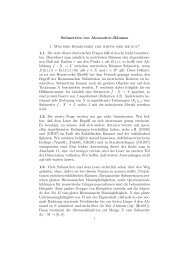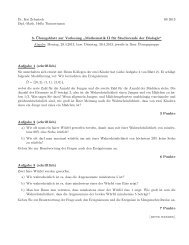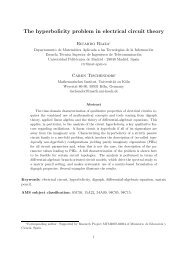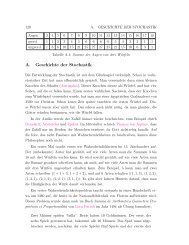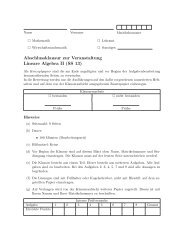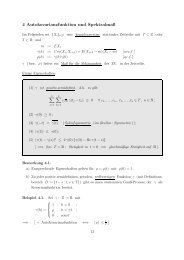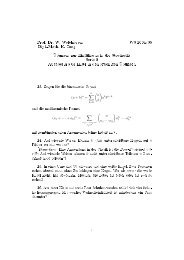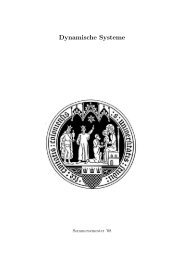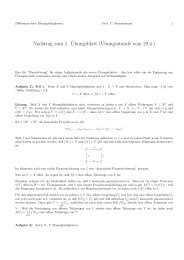Inhaltsverzeichnis - Mathematisches Institut der Universität zu Köln
Inhaltsverzeichnis - Mathematisches Institut der Universität zu Köln
Inhaltsverzeichnis - Mathematisches Institut der Universität zu Köln
Create successful ePaper yourself
Turn your PDF publications into a flip-book with our unique Google optimized e-Paper software.
DMV Tagung 2011 - <strong>Köln</strong>, 19. - 22. September<br />
Mario Kaip<br />
<strong>Universität</strong> Konstanz<br />
Mixed or<strong>der</strong> systems and application to parabolic boundary value problems<br />
In this talk we want to present some results on mixed or<strong>der</strong> systems on L p -spaces and applications<br />
to free boundary value problems. Using the H ∞ -calculus concept we introduce an functional calculus<br />
for the time and space <strong>der</strong>ivatives. After an analysis of the or<strong>der</strong> structure of each component of the<br />
mixed or<strong>der</strong> system we can determine mapping properties in a comfortable way. One major aspect of<br />
this work is the possibility to consi<strong>der</strong> mixed or<strong>der</strong> systems on spaces of mixed Besov and Bessel scales<br />
as 0B 1−1/(2p)<br />
p<br />
(R+,Lp(R n )) ∩ Lp(R+,B 2−1/p<br />
p<br />
(R n )). Therefore we are able to handle mixed or<strong>der</strong> systems<br />
realized on parabolic trace spaces for example.<br />
In L p theory free boundary value problems are usually reduced to the boundary where the natural spaces<br />
are of mixed Besov and Bessel type. With our method we can interpret the reduced problem as a mixed<br />
or<strong>der</strong> system and solve this at one stroke. With this approach we can avoid many auxiliary problems<br />
which occurs when the problem is solved ’manually’. The method can be applied to the generalized Lp-Lq<br />
Stokes problem on R n , the generalized thermo-elastic plate equations on R n , the spin-coating process,<br />
the two-phase Navier-Stokes with Boussinesq-Scriven surface and gravity, the two phase Stefan problem<br />
with Gibbs-Thomson correction, etc.<br />
Literatur<br />
Bothe, D. and Prüss, J. (2010). On the two-phase Navier-Stokes equations with Boussinesq-Scriven surface<br />
fluid. J. Math. Fluid Mech., 12, 1, 133-150.<br />
Denk, R. and Saal, J. and Seiler, J. (2008). Inhomogeneous symbols, the Newton polygon, and maximal<br />
L p -regularity. Russian J. Math. Phys, 8, 523-556.<br />
Denk, R. and Volevich, L. R. (2008). Parabolic boundary value problems connected with the Newtons’s<br />
polygon and some problems of crystallization. J. Evol. Equ., 8, 523-556.<br />
Dore, G. and Venni, A. (2005). H ∞ functional calculus for sectorial and bisectorial operators. Studia Math.,<br />
166, 3, 221-241.<br />
Gindikin, S. and Volevich, L. R. (1992). The method of Newton’s polyhedron in the theory of partial differential<br />
equations. Mathematics and its Applications (Soviet Series), Kluwer Academic Publishers Group,<br />
86.<br />
Prüss, J. and Simonett, G. (2010). On the two-phase Navier-Stokes equations with surface tension. Interfaces<br />
and Free Boundaries. Mathematical Modelling, Analysis and Computation, 12, 3, 311-345.<br />
53




